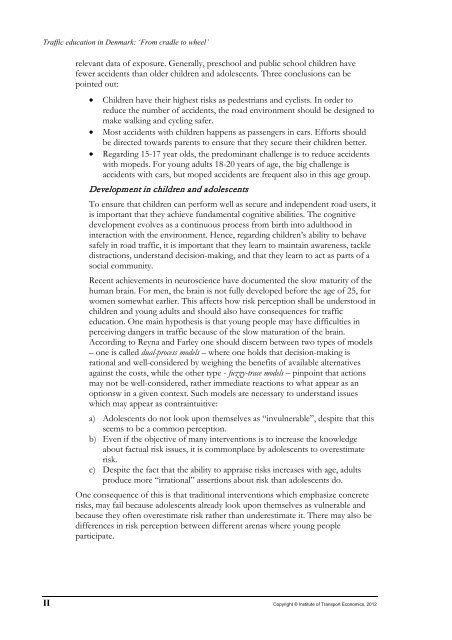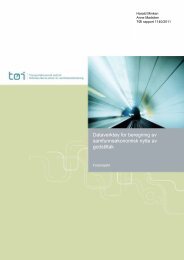Trafikkopplæring i Danmark 'fra vugge til rat' - Transportøkonomisk ...
Trafikkopplæring i Danmark 'fra vugge til rat' - Transportøkonomisk ...
Trafikkopplæring i Danmark 'fra vugge til rat' - Transportøkonomisk ...
Create successful ePaper yourself
Turn your PDF publications into a flip-book with our unique Google optimized e-Paper software.
Traffic education in Denmark: ‘From cradle to wheel’<br />
relevant data of exposure. Generally, preschool and public school children have<br />
fewer accidents than older children and adolescents. Three conclusions can be<br />
pointed out:<br />
• Children have their highest risks as pedestrians and cyclists. In order to<br />
reduce the number of accidents, the road environment should be designed to<br />
make walking and cycling safer.<br />
• Most accidents with children happens as passengers in cars. Efforts should<br />
be directed towards parents to ensure that they secure their children better.<br />
• Regarding 15-17 year olds, the predominant challenge is to reduce accidents<br />
with mopeds. For young adults 18-20 years of age, the big challenge is<br />
accidents with cars, but moped accidents are frequent also in this age group.<br />
Development in children and adolescents<br />
To ensure that children can perform well as secure and independent road users, it<br />
is important that they achieve fundamental cognitive abilities. The cognitive<br />
development evolves as a continuous process from birth into adulthood in<br />
interaction with the environment. Hence, regarding children’s ability to behave<br />
safely in road traffic, it is important that they learn to maintain awareness, tackle<br />
distractions, understand decision-making, and that they learn to act as parts of a<br />
social community.<br />
Recent achievements in neuroscience have documented the slow maturity of the<br />
human brain. For men, the brain is not fully developed before the age of 25, for<br />
women somewhat earlier. This affects how risk perception shall be understood in<br />
children and young adults and should also have consequences for traffic<br />
education. One main hypothesis is that young people may have difficulties in<br />
perceiving dangers in traffic because of the slow maturation of the brain.<br />
According to Reyna and Farley one should discern between two types of models<br />
– one is called dual-process models – where one holds that decision-making is<br />
rational and well-considered by weighing the benefits of available alternatives<br />
against the costs, while the other type - fuzzy-trace models – pinpoint that actions<br />
may not be well-considered, rather immediate reactions to what appear as an<br />
optionsw in a given context. Such models are necessary to understand issues<br />
which may appear as contraintuitive:<br />
a) Adolescents do not look upon themselves as “invulnerable”, despite that this<br />
seems to be a common perception.<br />
b) Even if the objective of many interventions is to increase the knowledge<br />
about factual risk issues, it is commonplace by adolescents to overestimate<br />
risk.<br />
c) Despite the fact that the ability to appraise risks increases with age, adults<br />
produce more “irrational” assertions about risk than adolescents do.<br />
One consequence of this is that traditional interventions which emphasize concrete<br />
risks, may fail because adolescents already look upon themselves as vulnerable and<br />
because they often overestimate risk rather than underestimate it. There may also be<br />
differences in risk perception between different arenas where young people<br />
participate.<br />
II Copyright © Institute of Transport Economics, 2012







